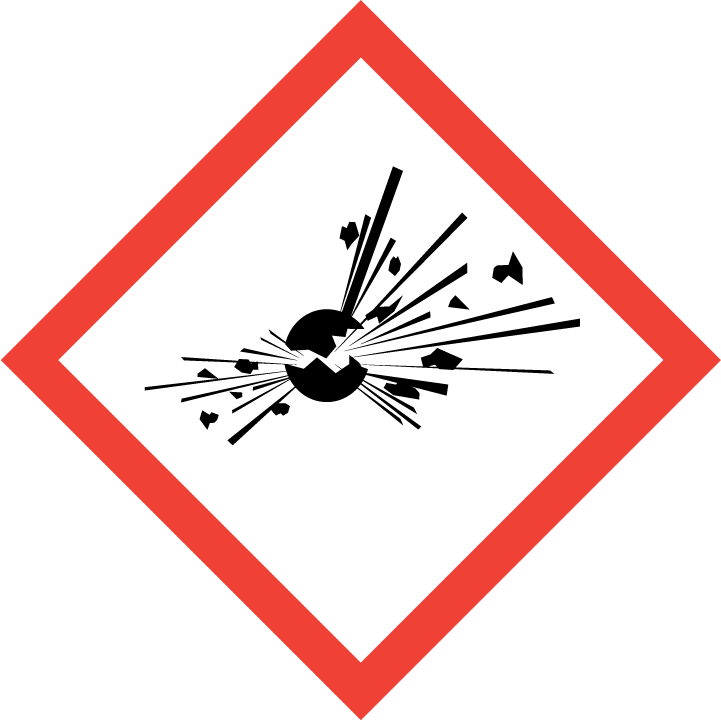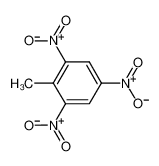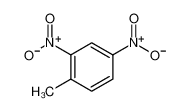1.Identification
1.1 GHS Product identifier
| Product name | 2,4,6-trinitrotoluene |
|---|
1.2 Other means of identification
| Product number | - |
|---|---|
| Other names | 1-methyl-2,4,6-trinitrobenzene |
1.3 Recommended use of the chemical and restrictions on use
| Identified uses | For industry use only. CBI,Laboratory chemicals,Propellants and blowing agents |
|---|---|
| Uses advised against | no data available |
1.4 Supplier's details
| Company | MOLBASE (Shanghai) Biotechnology Co., Ltd. |
|---|---|
| Address | Floor 4 & 5, Building 12, No. 1001 North Qinzhou Road, Xuhui District, Shanghai, China |
| Telephone | +86(21)64956998 |
| Fax | +86(21)54365166 |
1.5 Emergency phone number
| Emergency phone number | +86-400-6021-666 |
|---|---|
| Service hours | Monday to Friday, 9am-5pm (Standard time zone: UTC/GMT +8 hours). |
2.Hazard identification
2.1 Classification of the substance or mixture
Explosives, Division 1.1
Acute toxicity - Oral, Category 3
Acute toxicity - Dermal, Category 3
Acute toxicity - Inhalation, Category 3
Specific target organ toxicity – repeated exposure, Category 2
Hazardous to the aquatic environment, long-term (Chronic) - Category Chronic 2
2.2 GHS label elements, including precautionary statements
| Pictogram(s) |     |
|---|---|
| Signal word | Danger |
| Hazard statement(s) | H201 Explosive; mass explosion hazard H301 Toxic if swallowed H311 Toxic in contact with skin H331 Toxic if inhaled H373 May cause damage to organs through prolonged or repeated exposure H411 Toxic to aquatic life with long lasting effects |
| Precautionary statement(s) | |
| Prevention | P210 Keep away from heat, hot surfaces, sparks, open flames and other ignition sources. No smoking. P230 Keep wetted with … P234 Keep only in original packaging. P240 Ground and bond container and receiving equipment. P250 Do not subject to grinding/shock/friction/…. P280 Wear protective gloves/protective clothing/eye protection/face protection. P264 Wash ... thoroughly after handling. P270 Do not eat, drink or smoke when using this product. P261 Avoid breathing dust/fume/gas/mist/vapours/spray. P271 Use only outdoors or in a well-ventilated area. P260 Do not breathe dust/fume/gas/mist/vapours/spray. P273 Avoid release to the environment. |
| Response | P370+P372+P380+P373 In case of fire: Explosion risk. Evacuate area. DO NOT fight fire when fire reaches explosives. P301+P310 IF SWALLOWED: Immediately call a POISON CENTER/doctor/… P321 Specific treatment (see ... on this label). P330 Rinse mouth. P302+P352 IF ON SKIN: Wash with plenty of water/... P312 Call a POISON CENTER/doctor/…if you feel unwell. P361+P364 Take off immediately all contaminated clothing and wash it before reuse. P304+P340 IF INHALED: Remove person to fresh air and keep comfortable for breathing. P311 Call a POISON CENTER/doctor/… P314 Get medical advice/attention if you feel unwell. P391 Collect spillage. |
| Storage | P401 Store in accordance with… P405 Store locked up. P403+P233 Store in a well-ventilated place. Keep container tightly closed. |
| Disposal | P501 Dispose of contents/container to ... |
2.3 Other hazards which do not result in classification
none
3.Composition/information on ingredients
3.1 Substances
| Chemical name | Common names and synonyms | CAS number | EC number | Concentration |
|---|---|---|---|---|
| 2,4,6-trinitrotoluene | 2,4,6-trinitrotoluene | 118-96-7 | none | 100% |
4.First-aid measures
4.1 Description of necessary first-aid measures
General advice
Consult a physician. Show this safety data sheet to the doctor in attendance.
If inhaled
Fresh air, rest. Artificial respiration may be needed. Refer for medical attention.
In case of skin contact
Remove contaminated clothes. Rinse and then wash skin with water and soap. Refer for medical attention . Wear protective gloves when administering first aid.
In case of eye contact
First rinse with plenty of water for several minutes (remove contact lenses if easily possible), then refer for medical attention.
If swallowed
Rinse mouth. Induce vomiting (ONLY IN CONSCIOUS PERSONS!). Wear protective gloves when inducing vomiting.
4.2 Most important symptoms/effects, acute and delayed
SYMPTOMS: Symptoms of exposure to this compound may include headache, weakness, anemia, toxic hepatitis, cyanosis, dermatitis, jaundice, purpura, liver injury, conjunctivitis, irritation of the respiratory tract, constriction in the chest, lack of appetite, nausea, vomiting, diarrhea, petechial hemorrhages in the skin, oliguria, albuminuria, casts in urine, papular dermatitis, and yellow-orange discoloration of the hands, nails, face and hair. ACUTE/CHRONIC HAZARDS: This compound can be absorbed through the skin. The vapors are toxic. When heated to decomposition it emits toxic fumes. It will detonate under strong shock or sudden heating.
4.3 Indication of immediate medical attention and special treatment needed, if necessary
Basic treatment: Establish a patent airway (oropharyngeal or nasopharyngeal airway, if needed). Suction if necessary. Watch for signs of respiratory insufficiency and assist ventilations if necessary. Administer oxygen by nonrebreather mask at 10 to 15 L/min. Monitor for pulmonary edema and treat if necessary ... . Monitor for shock and treat if necessary ... . Anticipate seizures and treat if necessary ... . For eye contamination, flush eyes immediately with water. Irrigate each eye continuously with 0.9% saline (NS) during transport ... . Do not use emetics. For ingestion, rinse mouth and administer 5 ml/kg up to 200 ml of water for dilution if the patient can swallow, has a strong gag reflex, and does not drool. Administer activated charcoal ... . /Aromatic hydrocarbons and related compounds/
5.Fire-fighting measures
5.1 Extinguishing media
Suitable extinguishing media
If material on fire or involved in fire: Dangerously explosive. Flood with water. Cool all affected containers with flooding quantities of water. Apply water from as far a distance as possible. /Trinitrotoluene, wetted or TNT, wetted with not less than 30% water, by mass/
5.2 Specific hazards arising from the chemical
Flash point data for this chemical are not available. It is explosive.
5.3 Special protective actions for fire-fighters
Wear self-contained breathing apparatus for firefighting if necessary.
6.Accidental release measures
6.1 Personal precautions, protective equipment and emergency procedures
Use personal protective equipment. Avoid dust formation. Avoid breathing vapours, mist or gas. Ensure adequate ventilation. Evacuate personnel to safe areas. Avoid breathing dust. For personal protection see section 8.
6.2 Environmental precautions
Evacuate danger area! Consult an expert! Wet spilled material before picking it up, do not attempt to sweep up dry material. Do NOT wash away into sewer. Carefully collect remainder. Then store and dispose of according to local regulations. Do NOT let this chemical enter the environment. Personal protection: chemical protection suit including self-contained breathing apparatus.
6.3 Methods and materials for containment and cleaning up
Physical treatments, such as sorption by activated carbon or ion exchange resins or coagulation and filtration, are effective in removing TNT and other related cmpd present in munitions mfg wastewater.
7.Handling and storage
7.1 Precautions for safe handling
Avoid contact with skin and eyes. Avoid formation of dust and aerosols. Avoid exposure - obtain special instructions before use.Provide appropriate exhaust ventilation at places where dust is formed. For precautions see section 2.2.
7.2 Conditions for safe storage, including any incompatibilities
Fireproof. Separated from initiator explosives, food and feedstuffs and incompatible materials. See Chemical Dangers. Well closed. Store in an area without drain or sewer access. Provision to contain effluent from fire extinguishing.Fireproof. Separated from initiator explosives, food and feedstuffs, incompatible materials. See Chemical Dangers. Well closed.
8.Exposure controls/personal protection
8.1 Control parameters
Occupational Exposure limit values
Recommended Exposure Limit: 10 Hr Time-Weighted Avg: 0.5 mg/cu m, skin.
Biological limit values
no data available
8.2 Appropriate engineering controls
Handle in accordance with good industrial hygiene and safety practice. Wash hands before breaks and at the end of workday.
8.3 Individual protection measures, such as personal protective equipment (PPE)
Eye/face protection
Safety glasses with side-shields conforming to EN166. Use equipment for eye protection tested and approved under appropriate government standards such as NIOSH (US) or EN 166(EU).
Skin protection
Wear impervious clothing. The type of protective equipment must be selected according to the concentration and amount of the dangerous substance at the specific workplace. Handle with gloves. Gloves must be inspected prior to use. Use proper glove removal technique(without touching glove's outer surface) to avoid skin contact with this product. Dispose of contaminated gloves after use in accordance with applicable laws and good laboratory practices. Wash and dry hands. The selected protective gloves have to satisfy the specifications of EU Directive 89/686/EEC and the standard EN 374 derived from it.
Respiratory protection
Wear dust mask when handling large quantities.
Thermal hazards
no data available
9.Physical and chemical properties
| Physical state | yellow crystals |
|---|---|
| Colour | Monoclinic rhombohedra from alc; commercial crystals (needles) are yellow |
| Odour | Odorless |
| Melting point/ freezing point | 80.9ºC |
| Boiling point or initial boiling point and boiling range | 240ºC |
| Flammability | Combustible Solid (Class A Explosive)Many reactions may cause fire or explosion. |
| Lower and upper explosion limit / flammability limit | no data available |
| Flash point | 167.1ºC |
| Auto-ignition temperature | no data available |
| Decomposition temperature | 240°C |
| pH | no data available |
| Kinematic viscosity | no data available |
| Solubility | Insoluble |
| Partition coefficient n-octanol/water (log value) | no data available |
| Vapour pressure | 1.49E-06mmHg at 25°C |
| Density and/or relative density | 1.654 |
| Relative vapour density | 7.85 (Air = 1) |
| Particle characteristics | no data available |
10.Stability and reactivity
10.1 Reactivity
no data available
10.2 Chemical stability
Stable under recommended storage conditions.
10.3 Possibility of hazardous reactions
Explosive. Many reactions may cause fire or explosion.TRINITROTOLUENE-TRINITROBENZENE MIXTURE is sensitive to heat and shock. This compound reacts with reducing agents. It will detonate if vigorously shocked or heated to 232.22°C.
10.4 Conditions to avoid
no data available
10.5 Incompatible materials
TNT and potassium hydroxide in methanol will interact even at -65°C to give explosive acid-nitro salts (presumably o-quinonoid, or possibly Meisenheimer complexes). The explosion temperature is lowered to 160°C by the presence of a little potassium hydroxide.
10.6 Hazardous decomposition products
Heat of decomposition was determined as 5.1 kJ/g.
11.Toxicological information
Acute toxicity
- Oral: LD50 Mouse oral 660 mg/kg.
- Inhalation: no data available
- Dermal: no data available
Skin corrosion/irritation
no data available
Serious eye damage/irritation
no data available
Respiratory or skin sensitization
no data available
Germ cell mutagenicity
no data available
Carcinogenicity
CLASSIFICATION: C; possible human carcinogen. BASIS FOR CLASSIFICATION: Evidence of human carcinogenicity is inadequate. Urinary bladder papilloma and carcinoma were observed in female Fischer 344 rats. Mutagenic activity was observed in Salmonella with and without metabolic activation. HUMAN CARCINOGENICITY DATA: None. ANIMAL CARCINOGENICITY DATA: Limited.
Reproductive toxicity
no data available
STOT-single exposure
no data available
STOT-repeated exposure
no data available
Aspiration hazard
no data available
12.Ecological information
12.1 Toxicity
- Toxicity to fish: LC50 Lepomis macrochirus (bluegill sunfish) is 2.7 mg/l with a mean weight of 0.39 g in a 96 hr at 10°C /Static Bioassay
- Toxicity to daphnia and other aquatic invertebrates: LC50 Daphnia magna >4.4 mg/l/48 hr at 20°C /Flow through Bioassay
- Toxicity to algae: EC50; Species: Pseudokirchneriella subcapitata (Green algae); Conditions: freshwater; static; Concentration: 2.5 uM (95% confidence limit: 2.1 to 2.9 uM) for 96 hr; Effect: population, abundance /formulated product
- Toxicity to microorganisms: no data available
12.2 Persistence and degradability
AEROBIC: Mixed cultures of phenol-adapted microorganisms exhibited a slow but significantly higher rate of oxygen uptake in the presence of 2,4,6-trinitrotoluene at concn of 100 mg/L as compared to endogenous respiration, suggesting that 2,4,6-trinitrotoluene is oxidized(1). A treatability study employing static tube runs indicated that 2,4,6-trinitrotoluene can be oxidized at slow rates from 2,4,6-trinitrotoluene waste diluted with the domestic waste of an Army Ammunition plant; however, the rate of bioadsorption or bioprecipitation was greater than the oxidation rate(2). Activated sludge acclimated to 2,4,6-trinitrotoluene waste for 10 days was used as inoculum for five differing continuous flow runs with 2,4,6-trinitrotoluene concn at 5 mg intervals between 5 and 25 mg/L(2). Fifteen treatability runs of three differing detention times for each concn maintained a 65% average removal efficiency and generally the removal efficiencies tended to decrease with a decrease in detention time and increase in 2,4,6-trinitrotoluene concn(2). A portion of the 2,4,6-trinitrotoluene loss was due to bioadsorption on the activated sludge microorganisms and not due to molecular transformation(3). Composting studies have shown that thermophilic microorganisms produce the same reduction products as mesophilic microbes, no ring cleavage occurs and a large percentage of C14 labeled 2,4,6-trinitrotoluene is bound to the humus fraction(4-6). BOD tests on pure 2,4,6-trinitrotoluene and 2,4,6-trinitrotoluene waste water from the counter current-continuous flow TNT manufacturing process revealed that 2,4,6-trinitrotoluene was oxidized at slow rates(7-8). Attempts to relate BOD to the 2,4,6-trinitrotoluene removed were unsuccessful. It is likely that higher 2,4,6-trinitrotoluene concentrations are toxic to certain oxidizing microorganisms, which may prevent microbial metabolism of 2,4,6-trinitrotoluene(3). Raw sewage was found to be ineffective in degrading 2,4,6-trinitrotoluene, however a sewage sludge digester supernatant liquor caused a 64% reduction in 2,4,6-trinitrotoluene within 6 days(9).
12.3 Bioaccumulative potential
An estimated BCF of 3.4 was calculated in fish for 2,4,6-trinitrotoluene(SRC), using a log Kow of 1.60(1) and a regression-derived equation(2). According to a classification scheme(3), this BCF suggests the potential for bioconcentration in aquatic organisms is low(SRC).
12.4 Mobility in soil
Kp values for 2,4,6-trinitrotoluene sorption on 4 aquatic sediments measured 5.5, 14.3, 16.5 and 22.2 after 24-hr equilibration time, suggesting that the sorption of 2,4,6-trinitrotoluene is low(1). However most of the material absorbed is strongly bound and desorption from sediment is slow(1). Furthermore sorption of 2,4,6-trinitrotoluene increases with increases in pH and temperature(1). Transformation products of 2,4,6-trinitrotoluene may absorb to sediments with the same intensity as 2,4,6-trinitrotoluene(1). Kp values of 5 sediments averaged 53 with a range between 35 and 84(2). According to a classification scheme(3), the corresponding Koc values, which range between 1,100 and 1,900 and average 1,600(2), suggest that 2,4,6-trinitrotoluene is expected to have low mobility in soil. A Kd value of 3.3 L/kg was given for soil from Nebraska Ordinance Plant(4). An average Kd value of 4.0 was determined in 14 different soils(5). Mobility of 2,4,6-trinitrotoluene was enhanced with strong hydrated(Na+, Ca+) or diminished with weakly hydrated (K+) cations(6). 2,4,6-Trinitrotoluenes affinity for phyllosilicates (Kl = 0.496 L/umol) may displace other nitroaromatic compounds effecting its transport through the soil(7). Sorption coefficients for 2,4,6-trinitrotoluene were given in topsoil samples as 6.38 L/kg and in illite as 223.63 L/kg(8). Desorption coefficients for 2,4,6-trinitrotoluene were given for topsoil as 12.01 L/kg and 265.98 L/kg in illite(8). Soil (pH 6.5, 5.3% clay, 1.7% organic matter) containing 11 mg/kg dry soil weight of 2,4,6-trinitrobenzene gave a Kd of 2.9 L/kg and average diffusion rate of 1.18X10-6 cu cm/sec, indicating slow transportation of 2,4,6-trinitrotoluene through the soil(9).
12.5 Other adverse effects
no data available
13.Disposal considerations
13.1 Disposal methods
Product
The material can be disposed of by removal to a licensed chemical destruction plant or by controlled incineration with flue gas scrubbing. Do not contaminate water, foodstuffs, feed or seed by storage or disposal. Do not discharge to sewer systems.
Contaminated packaging
Containers can be triply rinsed (or equivalent) and offered for recycling or reconditioning. Alternatively, the packaging can be punctured to make it unusable for other purposes and then be disposed of in a sanitary landfill. Controlled incineration with flue gas scrubbing is possible for combustible packaging materials.
14.Transport information
14.1 UN Number
| ADR/RID: UN0209 | IMDG: UN0209 | IATA: UN0209 |
14.2 UN Proper Shipping Name
| ADR/RID: TRINITROTOLUENE (TNT), dry or wetted with less than 30% water, by mass† |
| IMDG: TRINITROTOLUENE (TNT), dry or wetted with less than 30% water, by mass† |
| IATA: TRINITROTOLUENE (TNT), dry or wetted with less than 30% water, by mass† |
14.3 Transport hazard class(es)
| ADR/RID: 1.1 | IMDG: 1.1 | IATA: 1.1 |
14.4 Packing group, if applicable
| ADR/RID: unknown | IMDG: unknown | IATA: unknown |
14.5 Environmental hazards
| ADR/RID: yes | IMDG: yes | IATA: yes |
14.6 Special precautions for user
no data available
14.7 Transport in bulk according to Annex II of MARPOL 73/78 and the IBC Code
no data available
15.Regulatory information
15.1 Safety, health and environmental regulations specific for the product in question
| Chemical name | Common names and synonyms | CAS number | EC number |
|---|---|---|---|
| 2,4,6-trinitrotoluene | 2,4,6-trinitrotoluene | 118-96-7 | none |
| European Inventory of Existing Commercial Chemical Substances (EINECS) | Listed. | ||
| EC Inventory | Listed. | ||
| United States Toxic Substances Control Act (TSCA) Inventory | Listed. | ||
| China Catalog of Hazardous chemicals 2015 | Listed. | ||
| New Zealand Inventory of Chemicals (NZIoC) | Listed. | ||
| Philippines Inventory of Chemicals and Chemical Substances (PICCS) | Listed. | ||
| Vietnam National Chemical Inventory | Not Listed. | ||
| Chinese Chemical Inventory of Existing Chemical Substances (China IECSC) | Listed. | ||
16.Other information
Information on revision
| Creation Date | Aug 15, 2017 |
|---|---|
| Revision Date | Aug 15, 2017 |
Abbreviations and acronyms
- CAS: Chemical Abstracts Service
- ADR: European Agreement concerning the International Carriage of Dangerous Goods by Road
- RID: Regulation concerning the International Carriage of Dangerous Goods by Rail
- IMDG: International Maritime Dangerous Goods
- IATA: International Air Transportation Association
- TWA: Time Weighted Average
- STEL: Short term exposure limit
- LC50: Lethal Concentration 50%
- LD50: Lethal Dose 50%
- EC50: Effective Concentration 50%
References
- IPCS - The International Chemical Safety Cards (ICSC), website: http://www.ilo.org/dyn/icsc/showcard.home
- HSDB - Hazardous Substances Data Bank, website: https://toxnet.nlm.nih.gov/newtoxnet/hsdb.htm
- IARC - International Agency for Research on Cancer, website: http://www.iarc.fr/
- eChemPortal - The Global Portal to Information on Chemical Substances by OECD, website: http://www.echemportal.org/echemportal/index?pageID=0&request_locale=en
- CAMEO Chemicals, website: http://cameochemicals.noaa.gov/search/simple
- ChemIDplus, website: http://chem.sis.nlm.nih.gov/chemidplus/chemidlite.jsp
- ERG - Emergency Response Guidebook by U.S. Department of Transportation, website: http://www.phmsa.dot.gov/hazmat/library/erg
- Germany GESTIS-database on hazard substance, website: http://www.dguv.de/ifa/gestis/gestis-stoffdatenbank/index-2.jsp
- ECHA - European Chemicals Agency, website: https://echa.europa.eu/




















